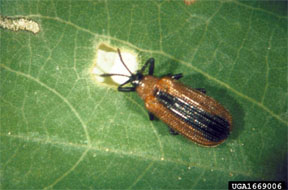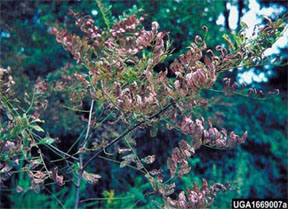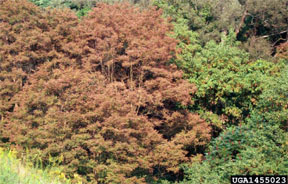Groups of slender trees turning brown along I-94 in southwest Michigan
Editor’s note: This article is from the archives of the MSU Crop Advisory Team Alerts. Check the label of any pesticide referenced to ensure your use is included.
This seems to be a big year for a southern leaf-mining beetle that feeds on black locust and sometimes honeylocust trees in the southern Midwest states up to the latitude of southern Michigan (the range of black locust trees): the locust leafminer (Odontota orsalis). This small (one-eighth of an inch long), colorful beetle deposits eggs inside black locust leaves where the larvae feed, creating leaf mines that eventually turn the leaves brown. Heavy infestations cause entire trees or groups of trees to turn brown. If this has happened to trees on your property, don’t panic and cut them down. Late season browning or defoliation may weaken trees, but it rarely kills them. The trees are likely to push out a new set of leaves next spring. Trees can be protected from locust leafminers by spraying the foliage with products that contain bifenthrin (Talstar, Onyx), permethrin (Astro) or cyfluthrin (Tempo, Bayer Multi-Insect Killer) in late May as soon as the leaves are expanded. An alternative treatment is basal application of imidacloprid (Merit, Xytect or Bayer Tree and Shrub Insect Control) at the rate given for borers. Most of the imidacloprid products now recommend two basal applications (instead of one) for trees with a trunk diameter greater than 12 inches.

Locust leafminer adult.

Locust leafminer damage to black locust leaves.

Locust leafminer damage as it now appears
at some points along I-94 in southwest
Michigan.
Dr. Smitley's work is funded in part by MSU's AgBioResearch.



 Print
Print Email
Email




